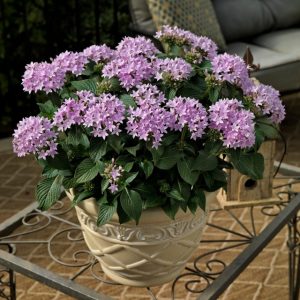by Ken Lain, the mountain gardener
Pentas plants are annual mountain flowers tailor-made for butterflies. The nectar-rich flowers grow in clusters over several seasons in vibrant red, pink, and purple irresistible to butterflies. Clusters of many shallow blooms provide easy access for the butterfly proboscis, allowing the insects to dip into many flowers in a short period. Honeybees like them as well, so add some into your pollinator gardens for increased activity.

Pentas lanceolata, belongs to the Rubiaceae family, which includes other prized ornamentals like gardenias, even coffee. You may see this bloomer described at the garden center by its common names’ starflower, Egyptian starflower, or a star cluster. You can grow pentas anywhere as an annual; in desert zones, 9+ and warmer plants may even perennialize.
Botanical Name – Pentas lanceolata
Common Name – Egyptian Star Cluster
Plant Type – Annual
Mature Size – 18-24 inches
Sun Exposure – Full sun to partial shade
Soil Type – Fertile with good drainage
Soil pH – Mildly acidic
Bloom Time – heat of Summer
Flower Color – Red, pink, lavender, or white
Hardiness Zones – 6–11
Native Area – Africa
How to Grow Egyptian Star Clusters
Pentas are tropical imports and grow wild in East Africa. Plants ideal for summer borders and containers: the average height of pentas is 18-24 inches. Plants that perennialize in frost-free zones may reach four feet tall or higher. The dark green foliage is slightly fuzzy. The five-petaled blossoms grow in three-inch clusters similar to other butterfly favorites like sedum, lantana, and Queen Anne’s lace. Blossom colors include pink, purple, white, and red. Penta plants can stay in bloom continuously under ideal growing conditions, so it’s worth weekly care to keep the plants in optimum health.
Many gardeners choose penta transplants to start in the garden, but you can try planting fresh pentas seed saved from last year’s flowers. Penta seeds require light to germinate, so don’t cover them with soil.
Light
Plants that receive at least three hours of direct sun will have the best flowers. Plants that don’t receive enough sunlight will stretch and become leggy. Plants prefer full sun, although some afternoon shade is tolerated.
Soil
Pentas appreciate a mildly acidic soil pH in the range of 6.0. Plant directly into Watters Organic Potting Soil, are heavily amending the soil with Watters Premium Mulch will increase the acidity of your soil for brighter flowers.
Water
Pentas need regular irrigation to stay healthy; keep the soil moisture about the same as a wrung-out sponge. Avoid regular overhead watering to prevent unsightly brown spots on the foliage.
Temperature and Humidity
With their tropical origin, Egyptian star clusters love heat and humidity and thrive in warm climates.
Fertilizer
Fertilize pentas twice per month with Watters Flower Power when in bloom.
Potting and Repotting
Pentas thrive in containers or pots. They can be grown indoors in rooms with bright indoor light. Bring plants indoors before the first frost, or take cuttings from desired varieties. A cool place with bright light is an ideal spot to overwinter plants. Keep indoor plants vigorous by adding a supplementary light source, and by increasing the humidity with a gravel-and-water filled tray.
Pruning
In frost-free growing zones, pentas will exhibit their shrubby nature. Prune the plants to six inches in January, when bloom production is at its lowest. After several seasons, the stems of the pentas may become so woody it’s worth replacing them. When growing as an annual for one season, no pruning is necessary, but regular deadheading will keep the plants blooming productively.
Varieties to Try
New pentas cultivars feature disease resistance and also come in dwarf forms suitable for border edges and containers. The ‘Butterfly’ series is easy to grow from seed for gardeners who want to populate a large flowerbed on a budget. The ‘Graffiti’ series features compact mounding plants with large flower heads. ‘Kaleidoscope Appleblossom’ are early bloomers with pale pink and rose on the same flower. In wet areas or those that overhead water the ‘New Look’ series produces upright plants that don’t flop. If your growing season is short, try ‘Northern Lights,’ which continues to produce pale lavender flowers in cool temperatures.

